Sat, Apr 27, 2024
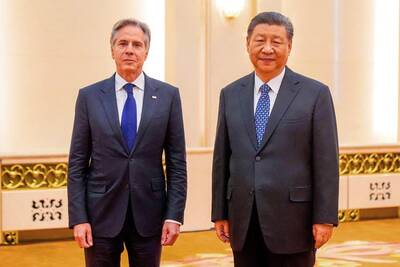
US Secretary of State Antony Blinken yesterday met with Chinese President Xi Jinping (習近平) and senior Chinese officials, stressing the importance of “responsibly managing” the differences between the US and China as the two sides butt heads over a number of contentious bilateral, regional and global

Chip testing and packaging service provider King Yuan Electronics Co (京元電子) yesterday said it plans to divest its Chinese subsidiary amid heightened geopolitical tensions and a US-China trade dispute that led to a drastic shuffle of the global semiconductor supply chain landscape.Intensifying compet
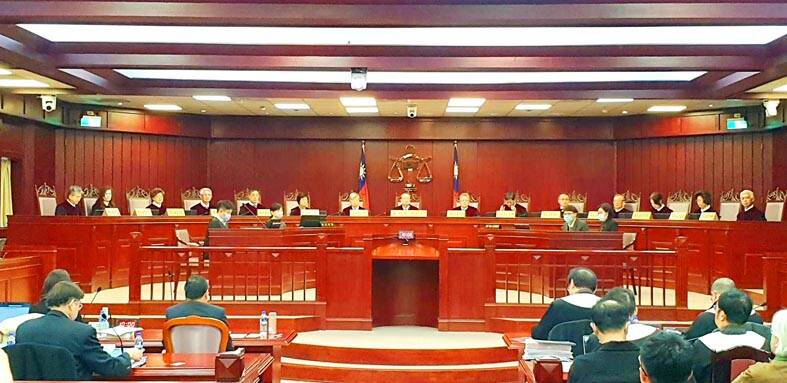
The Constitutional Court yesterday ruled that slander as a punishable crime is constitutional, but its scope should be better defined.The court heard 31 petitions for constitutional interpretation, including 20 filed by judges who said that slander was not clearly defined in practice and was not in

The US Federal Communications Commission (FCC) on Thursday ordered the US units of China Telecom Corp (中國電信), China Unicom Hong Kong Ltd (中國聯通) and China Mobile Ltd (中國移動) to discontinue fixed or mobile broadband Internet operations in the US.The FCC said it was requiring the Chinese carriers to dis
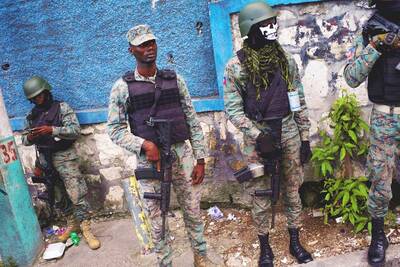
Haiti’s nine-member governing council began to take control of the troubled, gang-riven Caribbean nation as local media reported sporadic gunfire throughout parts of the capital.Composed of representatives from civil society and the private sector, the council was sworn in on Thursday during a rushe

CALL FOR DIALOGUE: The president-elect urged Beijing to engage with Taiwan’s ‘democratically elected and legitimate government’ to promote peace President-elect William Lai (賴清德) yesterday named the new heads of security and cross-strait affairs to take office after his inauguration on May 20, including National Security Council (NSC) Secretary-General Wellington Koo (顧立雄) to be the new defense minister and former Taichung mayor Lin Chia-lun
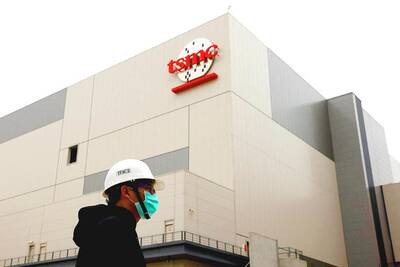
Taiwan Semiconductor Manufacturing Co (TSMC, 台積電) on Wednesday said that a new chip manufacturing technology called “A16” is to enter production in the second half of 2026, setting up a showdown with longtime rival Intel over who can make the fastest chips.TSMC, the world’s biggest contract manufact

FOUR COLORS: The design represents people from different backgrounds interacting with and supporting each other, Yen Design’s founder and director said Organizers yesterday unveiled the design for the presidential inauguration ceremony, which features a four-color theme symbolizing Taiwanese values.The organizers, the General Association of Chinese Culture, said that the neat and simple design for the May 20 ceremony is centered on ribbons of four
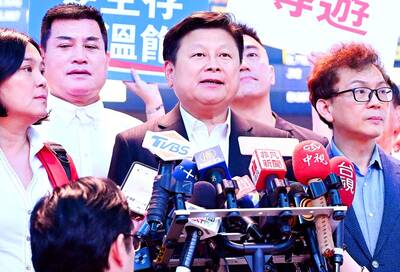
‘PEACE-THAWING’: The DPP warned the delegation ‘not to step on the red lines of democracy and national security,’ and referenced parts of the Anti-infiltration Act Chinese Nationalist Party (KMT) caucus whip Fu Kun-chi yesterday led a delegation of 17 KMT lawmakers to Beijing for a three-day visit, aiming to foster peace and prosperity across the Taiwan Strait.The trip represents the voice of Taiwanese and the largest party in the legislature, Fu said before d
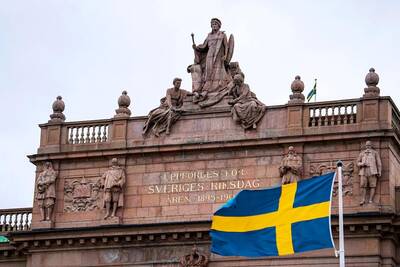
Swedish lawmakers have voiced support for Taiwan’s participation in the WHO and called on other EU members to do the same.“The WHO needs Taiwan more than Taiwan needs WHO,” Swedish-Taiwanese parliamentarian friendship group head Boriana Aberg told a seminar, the Taipei Mission in Sweden said on Wedn
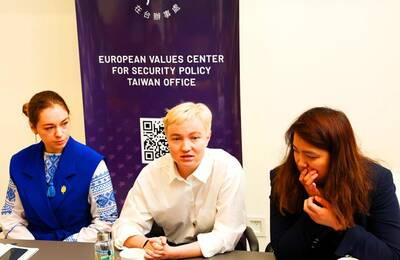
A delegation of Ukrainian non-governmental organizations visiting Taiwan yesterday called for more support and cooperation from democracies, including Taiwan, in the face of challenges from authoritarian regimes.“Democracies that are facing threats from authoritarian regimes should be supported” by
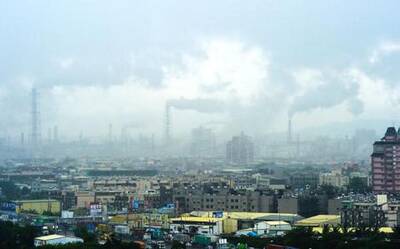
EPIDEMIOLOGY: A study conducted by researchers at Academia Sinica showed that exposure to air and noise pollution increases the metabolic syndrome risk ratio Exposure to air and noise pollution could quadruple the risks of cardiovascular diseases, diabetes and other conditions that fall under metabolic syndrome, a Taiwanese study published in Science Reports Wednesday last week showed.Coauthor Chan Ta-chien (詹大千), a research fellow at Academia Sinica’s R
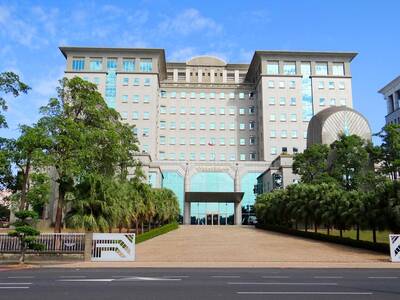
Public prosecutors indicted 15 people yesterday — five former city government officials and 10 members of Ysolar Group (力暘集團) — after an investigation into a controversial solar energy project in Tainan’s Cigu District (七股)The case involved former Tainan Economic Development Bureau chief Chen Kai-li
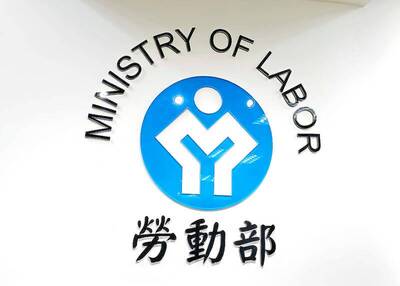
The Ministry of Labor (MOL) on Thursday said that it plans to eliminate its quota limit and points system to allow more foreign and overseas compatriot students to stay and work in Taiwan after graduation.In a special report submitted to the Legislative Yuan’s Social Welfare and Environmental Hygien
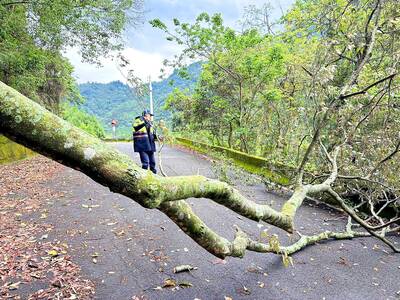
Falling trees killed two people in two separate cases, reports said yesterday.In Changhua County, a postman on a motorcycle surnamed Sun (孫), 46, was killed during yesterday’s rainstorm when a tree fell and struck him while he was delivering mail on a rural road in Fenyuan District (芬園).State-owned

CANCELED: Sidney apologized in a Facebook post on Thursday, but Kang Hsuan Educational Publishing said it does not want to be associated with ‘mean-spirited’ speech Kang Hsuan Educational Publishing Group yesterday became the 10th advertiser to sever ties with beleaguered Internet celebrity Sidney after the content creator seemingly mocked children with special needs in a livestream.Sidney, a pregnant woman with five children, runs multiple social media channel

GROWTH DRIVERS: The firm expects to benefit from generative AI applications for smartphones, higher average selling price of flagship chips and market share gains Smartphone chip designer MediaTek Inc (聯發科) yesterday said it estimates that revenue would expand at an annual rate of about 15 percent this year, as a proliferation of generative artificial intelligence (AI) applications for premium smartphones are fueling demand for its flagship smartphone chips.I

The government’s business climate monitor last month flashed “green” for the third consecutive month due to strong exports, which in turn benefited electrical and machinery equipment imports, the National Development Council (NDC) said yesterday.The total score of the nine constituent readings gaine

Google and Microsoft Corp shares rallied yesterday as the technology bellwethers showed that hefty investments into artificial intelligence (AI) could reap more immediate revenue returns, a sharp contrast to Meta Platforms Inc’s view that AI is a long-term bet.Microsoft’s shares advanced 3.84 percen
The victory of Vice President William Lai (賴清德) in January’s presidential election raised questions about the future of China’s unification strategy toward Taiwan.A decade ago, the assumption in Bejing had been that deepening economic ties with Taiwan would bring about a political accommodation even
On Wednesday last week, Chinese leader Xi Jinping (習近平) met with former president Ma Ying-jeou (馬英九) for the first time in nine years. It is noteworthy that Xi has removed his own term limits and virtually eliminated opposition within the party, while the Chinese Nationalist Party (KMT), to which Ma
In today’s era of breakneck-paced digital development, social media use has become a double-edged sword. It provides an unprecedented degree of connection, but with that comes unprecedented privacy and security risks.TikTok, a social media platform bewitching young people around the globe, has once

MILESTONE: Phil Foden became the third player to score 50 top-flight goals under Pep Guardiola aged 23 or younger after Lionel Messi and Erling Haaland Phil Foden struck twice on Thursday as Manchester City stepped up their bid for a fourth consecutive English Premier League crown with a ruthless 4-0 victory at Brighton & Hove Albion.A day after Liverpool’s title challenge suffered a huge blow with a 2-0 defeat at Everton, City kept up the pressure

The Denver Nuggets on Thurday rallied to push LeBron James and the Los Angeles Lakers to the brink of elimination from the NBA playoffs as the Philadelphia 76ers, fueled by 50 points from Joel Embiid, clawed back a win against the Knicks.Defending champions the Nuggets erased a 10-point first-quarte

Rafael Nadal on Thursday breezed to a straight-sets victory over 16-year-old Darwin Blanch to reach the Madrid Open second round as he began his farewell appearance in the Spanish capital.The 37-year-old this week said that he was not fully fit, but he demolished his American opponent 6-1, 6-0 in 1

Elias Diaz on Thursday capped Colorado’s six-run eighth inning with a tiebreaking RBI double as the Rockies beat the San Diego Padres 10-9.Elehuris Montero and Hunter Goodman homered for Colorado, which earned a split of the four-game series.Brenton Doyle and Brendan Rodgers each had three of the Ro
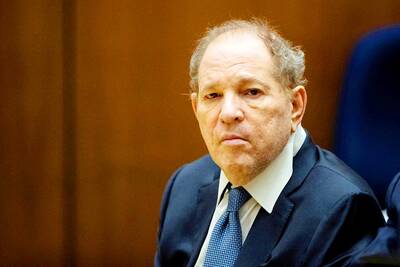
REVERSAL: ‘Today’s ruling unfortunately casts a dark shadow on their bravery and will undoubtedly deter future sexual assault victims from coming forward,’ a lawyer said Harvey Weinstein’s New York sexual assault conviction was overturned by the state’s highest court, which found that the judge in the disgraced Hollywood movie mogul’s 2020 trial had made fundamental errors.In a 4-3 decision, the New York Court of Appeals on Thursday ordered a new trial, saying the j
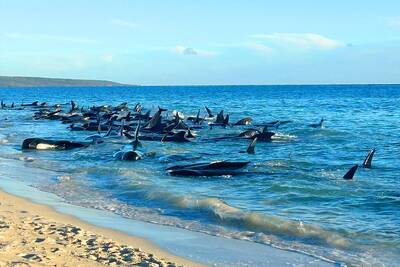
DISTURBING MYSTERY: What causes whales to strand as they did in Western Australia on Thursday is not clear to scientists and there are various theories about it More than 100 long-finned pilot whales that beached on the western Australian coast on Thursday have returned to sea, while 29 died on the shore, officials said.Ships and a spotter plane were monitoring the rescued whales in case they returned to shore, Western Australia Parks and Wildlife Service o

The University of Southern California (USC) on Thursday canceled its main graduation ceremony and dozens more college students were arrested at other campuses in the US as protests against the Israel-Hamas war continued to spread.College officials across the US are worried the ongoing protests could
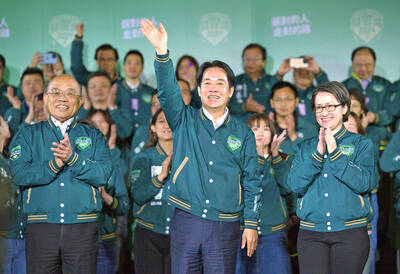
My previous column Donovan’s Deep Dives: The powerful political force that vanished from the English press on April 23 began with three paragraphs of what would be to most English-language readers today incomprehensible gibberish, but are very typical descriptions of Democratic Progressive Party (DP
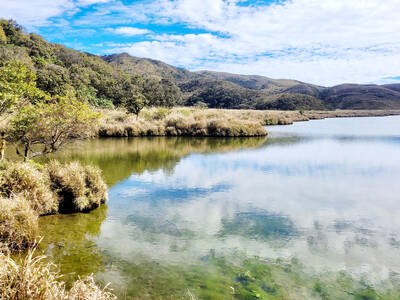
Years ago, I was thrilled when I came across a map online showing a fun weekend excursion: a long motorcycle ride into the mountains of Pingtung County (屏東) going almost up to the border with Taitung County (台東), followed by a short hike up to a mountain lake with the mysterious name of “Small Ghost
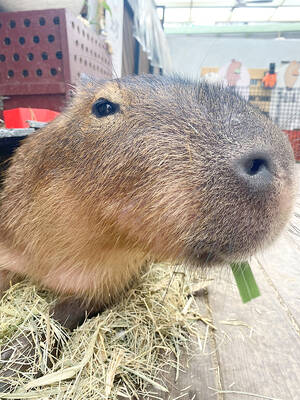
If you haven’t heard, capybaras are having a bit of a moment. The hashtag #capybara has over 10 billion views on TikTok and counting. Viral videos circulate of these big fluffy rodents engaging in sometimes ridiculous, sometimes hilarious behavior — surfing down the river on a crocodiles’ back or ba

A symbol of purity and cleanliness, the color white is the standard color for coats worn by doctors. While this has been the case for well over 100 years, it hasn’t always been so. In fact, before the late 19th century, doctors wore formal black attire, which was similar to that worn by clergymen. B

A: So who were Hollywood’s highest-paid stars of 2023?B: No. 5 to No. 2 were: Matt Damon with US$43 million, Ryan Gosling with US$43 million, Tom Cruise with US$45 million, and Margot Robbie with US$59 million.A: Didn’t Tom Cruise top the list?B: Nope, Adam Sandler was No.1, having made US$73 mi

A: “Forbes” magazine just revealed Hollywood’s top 10 highest-paid stars of 2023.B: How much did those superstars make last year?A: Denzel Washington was at No. 10, having made US$24 million, which is about NT$771 million.B: That’s an astronomical figure to me.A: No. 9 to No. 6 were: Ben Afflec
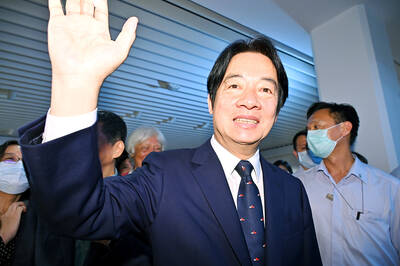
It’s certainly been a pleasure watching the presidential campaign launch of Chinese Nationalist Party (KMT) candidate Hou You-yi (侯友宜) lurch painfully about like a wounded pachyderm in search of an elephant graveyard. Hou’s fall to third place in some polls last week appears early, and it might still be recoverable. But grumbling in his party about replacing him has already begun. Indeed, all indications are that the party that twice gave us Lien Chan (連戰), the most despised politician in Taiwan, as a presidential candidate and later offered voters Hung Hsiu-chu (洪秀柱) and Han Kuo-yu (韓國瑜), is arcing along its normal descending trajectory, the North Korean missile test of electoral politics. A KIND OF POLICY PLATFORM Last week the KMT doubled down on this path with Hou’s calls for nuclear power and more death penalty executions, standard KMT fare for decades (the latter is unnecessary since so many potential criminals are likely to die in traffic accidents long before they harm anyone). Apparently KMT policy institutions are not echo chambers so much as mausoleums where dead ideas are embalmed and then periodically put on display. The lack of public policy imagination is obvious. A less obvious facet of KMT ineptitude: with years of speculation that Hou would be their man in 2024, neither Hou nor the party insisted on interesting or experimental public policies to showcase Hou’s greatness in preparation for the showdown. Of course, that is even more true of the Democratic Progressive Party (DPP). Hou’s slide and the media buzz surrounding it are obscuring the truly urgent problem the pro-Taiwan side faces: DPP presidential candidate William Lai (賴清德) has not expanded his voter support beyond the party base. In most polls he remains below 40 percent. Independent voters are staying away in droves, and for the moment the young are turning to
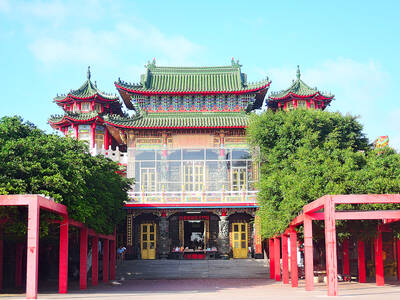
July 17 to July 23 When Yeh Ken-chuang (葉根壯) came of age, the traditional skills of architecture and carpentry that had been in his family for four generations were disappearing. After helping his uncle Yeh Teh-ling (葉得令) construct ships, residences and temples for more than a decade, Yeh struck out on his own at the age of 28 in 1960 as a damusi (大木司, chief carpenter), earning his lifelong title “Chief Chuang” (壯司). Around this time, builders in his homeland of Penghu were increasingly using reinforced concrete instead of wood, due to the humid climate. The period also saw a frenzy in temple construction as the economy improved, meaning there was plenty of work for Yeh. Adept in non-structural techniques such as doors, windows and furniture, as well as the intricate carvings and detailed decorations that adorned the structures, Yeh was able to adapt his skills, leading the reconstruction of the historic Hsiliao Daitian Temple (西寮代天宮) on Penghu’s main island in 1963. According to the book Crossing Traditions in Yeh Ken-chuang’s Large-scale Carpentry Skills (宮廟巧藝 :跨越傳統的葉根壯大木作技術), it was Penghu’s first temple that used a purely reinforced concrete structure. Before his life was cut short, Yeh created more than 70 temples and related structures across the various islands of Penghu and left behind more than 230 building plans. Although Yeh could have built temples and other structures on Taiwan proper, he only worked on a handful of projects outside of Penghu because he wanted to be close to his family. CLAN OF CARPENTERS The Yeh family’s woodworking tradition began with Yeh Ma-li (葉媽利), who learned the architecture and carpentry trade from an unknown master on Kinmen. The Yehs trace their roots to Kinmen, although this branch had been living in Penghu since the early 1600s. Yeh Ma-li was Penghu’s chief temple builder between 1860 and
| New Taipei City | 14-23 | 10% | |
| Hsinchu County | 14-22 | 10% | |
| Hsinchu City | 14-22 | 10% | |
| Taipei City | 14-22 | 10% | |
| Miaoli County | 12-22 | 10% | |
| Taoyuan City | 14-22 | 10% | |
| Keelung City | 15-21 | 10% |
| Yunlin County | 14-24 | 0% | |
| Taichung City | 14-24 | 0% | |
| Nantou County | 14-24 | 0% | |
| Changhua County | 14-23 | 0% |
| Chiayi County | 13-24 | 0% | |
| Chiayi City | 14-25 | 0% | |
| Tainan City | 15-22 | 0% | |
| Kaohsiung City | 17-23 | 0% | |
| Pingtung County | 16-25 | 0% |
| Yilan County | 14-22 | 10% | |
| Hualien County | 16-22 | 10% | |
| Taitung County | 17-23 | 10% |
| Kinmen County | 11-18 | 0% | |
| Penghu County | 17-20 | 0% | |
| Lienchiang County | 10-13 | 10% |